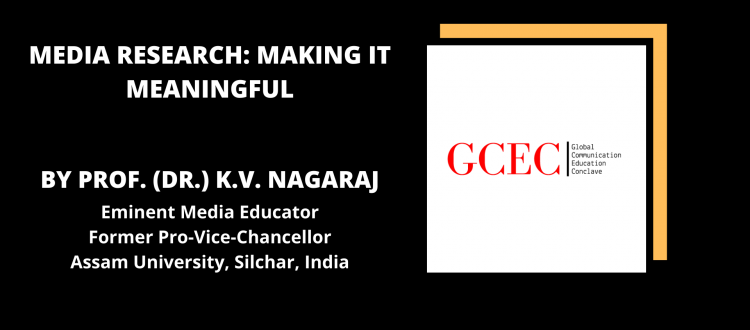Media Research: Making It Meaningful – Prof. K.V. Nagaraj
Media research all over the world has reached a stage of definitive acceptance. Even though the pace of acceptance is slow and the quality of research is to similarly improve by leaps and bounds, there is a realization for greater quality research in South Asia than ever before. Media research within academic portals has gained popularity. Media research can be categorized roughly into academic research and professional research for the market. Again, media research is further categorized into qualitative and quantitative research. The combination of the two methods is normally known as triangulation. Media research in particular is dogged by ethical conundrums as doing research in post truth and post structural times is not an easy proposition. In a country like India where the government programmes and projects have huge investments, the need for action research is all the more important, especially the role of media in making the beneficiaries aware of the finer aspects of such projects. While we cannot deny the role of interpersonal communication in sensitizing people as to their rights and duties, the media participation in those acts and actions cannot be ignored. Thus, the issue of making the media research relevant for the common good is to be addressed. The recent talk of de-westernizing media research may find takers in such contexts at least to some extent. While I am not so sure of inventing our own research methods, the possibility of making sincere efforts can be explored. That kind of an effort will also address the clamor for localized or native research of relevance. Yet another important area of meaningful research is among certain untouched communities and social groups. By employing ethnographic research tools one can bring out wonderful results. The north-eastern part of India has already made an active beginning in this direction. Any evaluation of socio-cultural life of a specific group of people in terms of their language and communication practices shall be exhilarating.
With all said and done, media research is basically multi-disciplinary. In fact, experts from other disciplines like sociology, psychology, political science, economics, anthropology, applied linguistics and the likes have initiated research in mass communication. This is true of both quantitative and qualitative research.
How can one be innovative in media research? Consider this possibility. For instance, why should we not apply qualitative methods drawn from literature and linguistics to media contents. One more innovative method is the media content analysis in the context of native culture and practical philosophy. I have included content analysis of newspapers in my research on the history of Kannada journalism to know in which direction the Kannada press was moving. On the other hand, we can also think of researching visual aesthetics in electronic media communication which can help those people who are involved. An interesting area can be the ethical issues generated by the new technologies of media.
Have you ever thought of the impact of media language on the psyche of the content consumers? A classy rhetorical analysis can be useful. Not much work has been done in the area of media management. I sincerely believe that there is a vast scope for media research in native languages across South Asia. Standardization of quality parameters will definitely help the non-English researchers who excel in their own language. Then we should use technology as well for this purpose. Native sociological finesse can be yet another fertile area for creative and out of the box innovations in media research that is meaningful to the society in which we live….Read More

